Usage#
jupyter_app_launcher relies on YAML files to create and add entries to the launcher. Depending on the type of entry, different parameters are required.
Configuration file location#
By default, jupyter_app_launcher will look for jupyter_app_launcher directory in the list of data directories of Jupyter (i.e. the data section of the jupyter --path command), for example:
> jupyter --path
config:
/home/***/mambaforge/envs/appdev/etc/jupyter
/home/***/.jupyter
/home/***/.local/etc/jupyter
/usr/local/etc/jupyter
/etc/jupyter
data: # -> Here are the paths used by jupyter_app_launcher
/home/***/mambaforge/envs/appdev/share/jupyter
/home/***/.local/share/jupyter
/usr/local/share/jupyter
/usr/share/jupyter
runtime:
/home/***/.local/share/jupyter/runtime
If under the jupyter_app_launcher directory of these paths, YAML files (.yaml, .yml) with name starting with jp_app_launcher exist, they will be used. For example, the following files will be loaded:
/home/***/mambaforge/envs/appdev/share/jupyter/jupyter_app_launcher/jp_app_launcher.yaml
/home/***/mambaforge/envs/appdev/share/jupyter/jupyter_app_launcher/jp_app_launcher_my_app.yml
/home/***/.local/share/jupyter/jupyter_app_launcher/jp_app_launcher_my_other_app.yml
In addition to this behavior, jupyter_app_launcher also loads the YAML files with names starting with jp_app_launcher in the directory where JupyterLab was started, and also in the path defined by the JUPYTER_APP_LAUNCHER_PATH environment variable.
Note
This extension only reads the configuration file when JupyterLab starts. Users need to restart JupyterLab after changing the config file.
Configuration file content#
The YAML file should contain an array of objects, jupyter_app_launcher will create the corresponding launcher entry for each object. Here is an example of the configuration file:
- title: Dashboard example
description: Example of opening a notebook in dashboard mode without Voila
source: ../../samples/sample.ipynb
cwd: ../../samples
type: notebook-grid
- title: Notebook example
description: Example of opening a notebook in dashboard mode without Voila
source: ../../samples/sample.ipynb
cwd: ../../samples
type: notebook
catalog: Another catalog
- title: Voila example
description: Example of opening a notebook in dashboard mode with Voila
source: ../../samples/sample.ipynb
cwd: ../../samples
type: notebook-voila
args:
theme: dark
catalog: Another catalog
- title: URL example
description: Example of opening a URL in a tab
source: https://jupyterlab.readthedocs.io/en/stable/
type: url
catalog: Another catalog
args:
sandbox: [ 'allow-same-origin', 'allow-scripts', 'allow-downloads', 'allow-modals', 'allow-popups']
- title: URL example (new window)
description: Example of opening a URL in a new browser window
source: https://jupyterlab.readthedocs.io/en/stable/
type: url
catalog: Another catalog
args:
createNewWindow: true
- title: Streamlit example
description: Example of opening a streamlit app
source: http://localhost:$PORT/
cwd: ./
type: local-server
args:
- streamlit
- run
- st_app.py
- --server.headless=true
- --server.port=$PORT
catalog: Another catalog
- title: Command example
description: Example of calling JupyterLab commands
type: jupyterlab-commands
source:
- label: Command 1
id: 'filebrowser:open-path'
args:
path: sample.ipynb
- label: Command 2
id: 'filebrowser:open-path'
args:
path: sample-2.ipynb
catalog: Another catalog
The common fields of the configurations are: title, description icon and catalog.
title: Title of the launcher entry.description(Optional): Description of the launcher entry. It will be shown on mouse hover.icon(Optional): Path to the icon of the launcher entry. If it is not defined, the initials of the title will be used as the icon.catalog(Optional): Catalog of the launcher entry, entry with the same catalog will be grouped in the same group in the launcher, If it is not defined, Jupyter App catalog will be used.
Other fields will have different meanings depending on the entry type. In this section, we will detail these fields for each type of entry.
Open a predefined notebook#
This launcher entry will create a new notebook in the current working directory of JupyterLab with predefined content.
- title: Notebook example
description: Example of opening a notebook in dashboard mode without Voila
source: ../../samples/sample.ipynb
cwd: ../../samples
type: notebook
catalog: Notebook catalog
type=notebooksource: Path to the notebook (can be stored anywhere) which will be copied to the current working directory of JupyterLab. It can be an absolute path or a relative path to the directory of the configuration file.cwd: Unused.
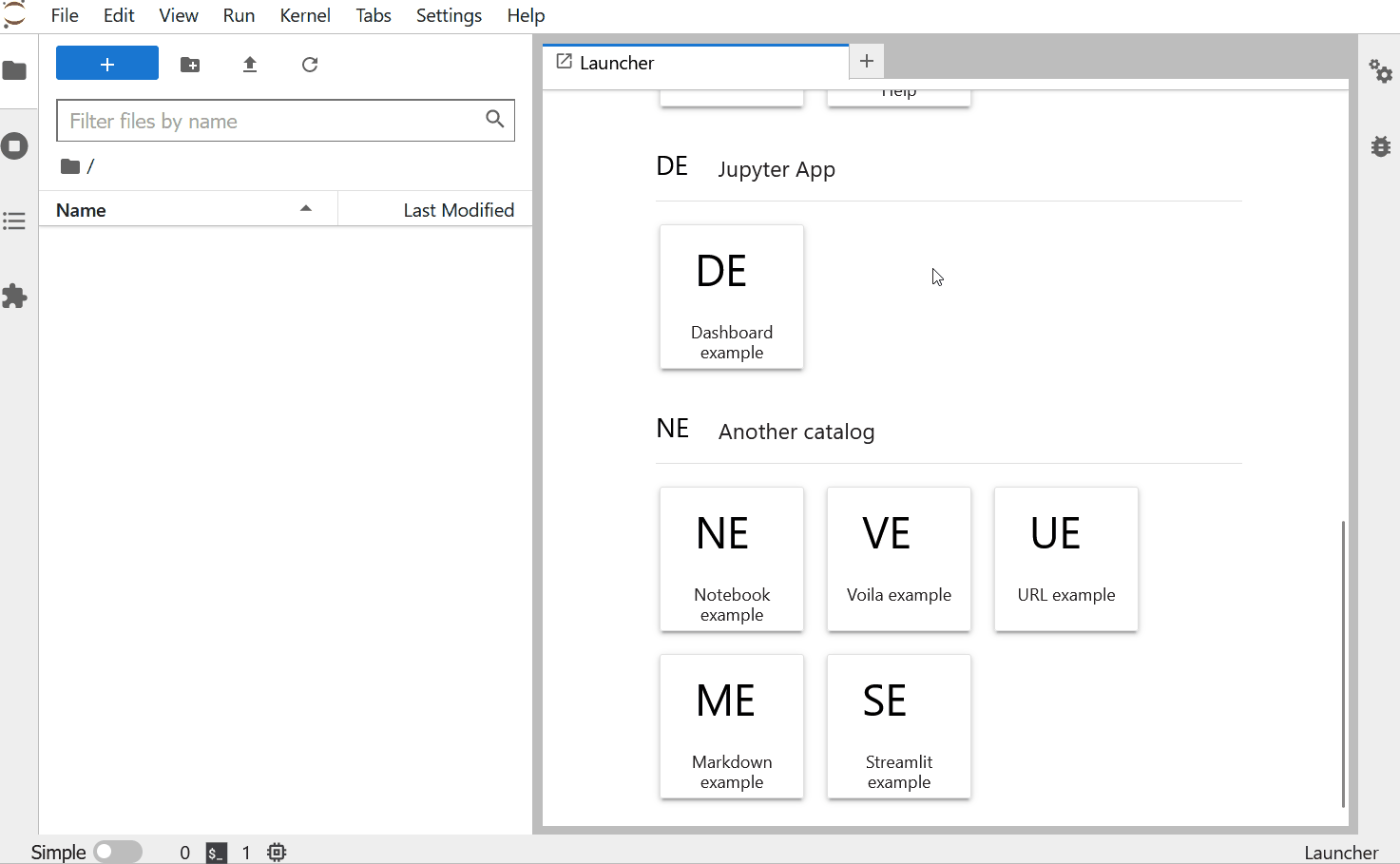
Notebook demo.#
Open a predefined markdown file#
This launcher entry will render the content of a predefined markdown file.
- title: Markdown example
description: Example of opening a Markdown file in a tab
source: ../../samples/sample.md
type: markdown
catalog: Another catalog
type=markdownsource: Path to the markdown file. It can be an absolute path or a relative path to the directory of the configuration file.cwd: Unused.
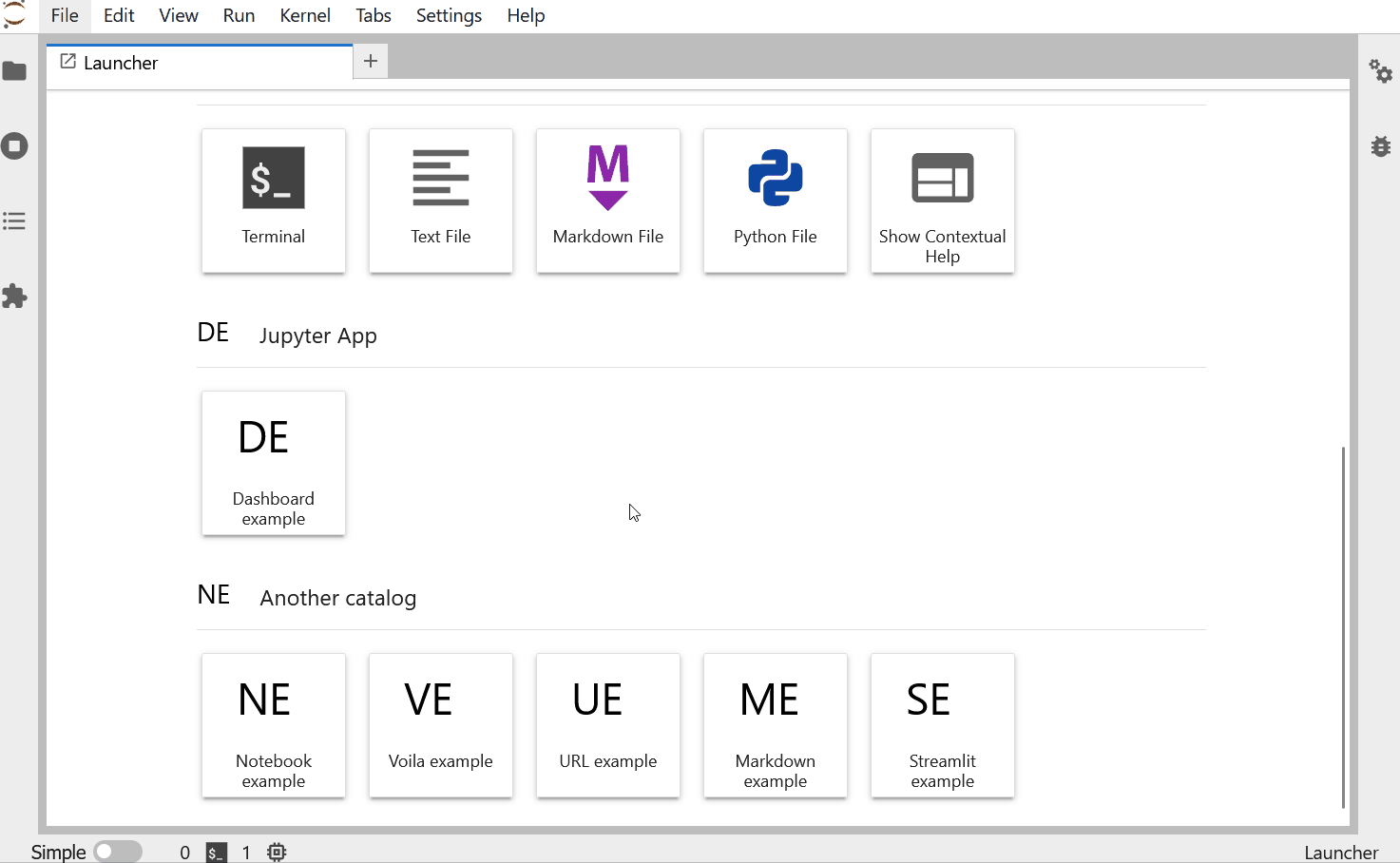
Markdown demo.#
Render a notebook in gridstack dashboard mode#
This launcher entry will open a predefined notebook in the gridstack dashboard view. Users need to use the jupyterlab-gridstack extension to edit the layout of the dashboard and save the dashboard metadata. The launcher entry will read the metadata and then render the notebook with the saved layout.
- title: Dashboard example
description: Example of opening a notebook in dashboard mode without Voila
source: ../../samples/sample.ipynb
cwd: ../../samples
type: notebook-grid
type=notebook-gridsource: Path to the notebook file. It can be stored anywhere on your system and can be an absolute path or a relative path to the directory of the configuration file.cwd: The working directory where the notebook will be started. it’s important to set this field correctly if you need to load local files with relative paths in your notebook.
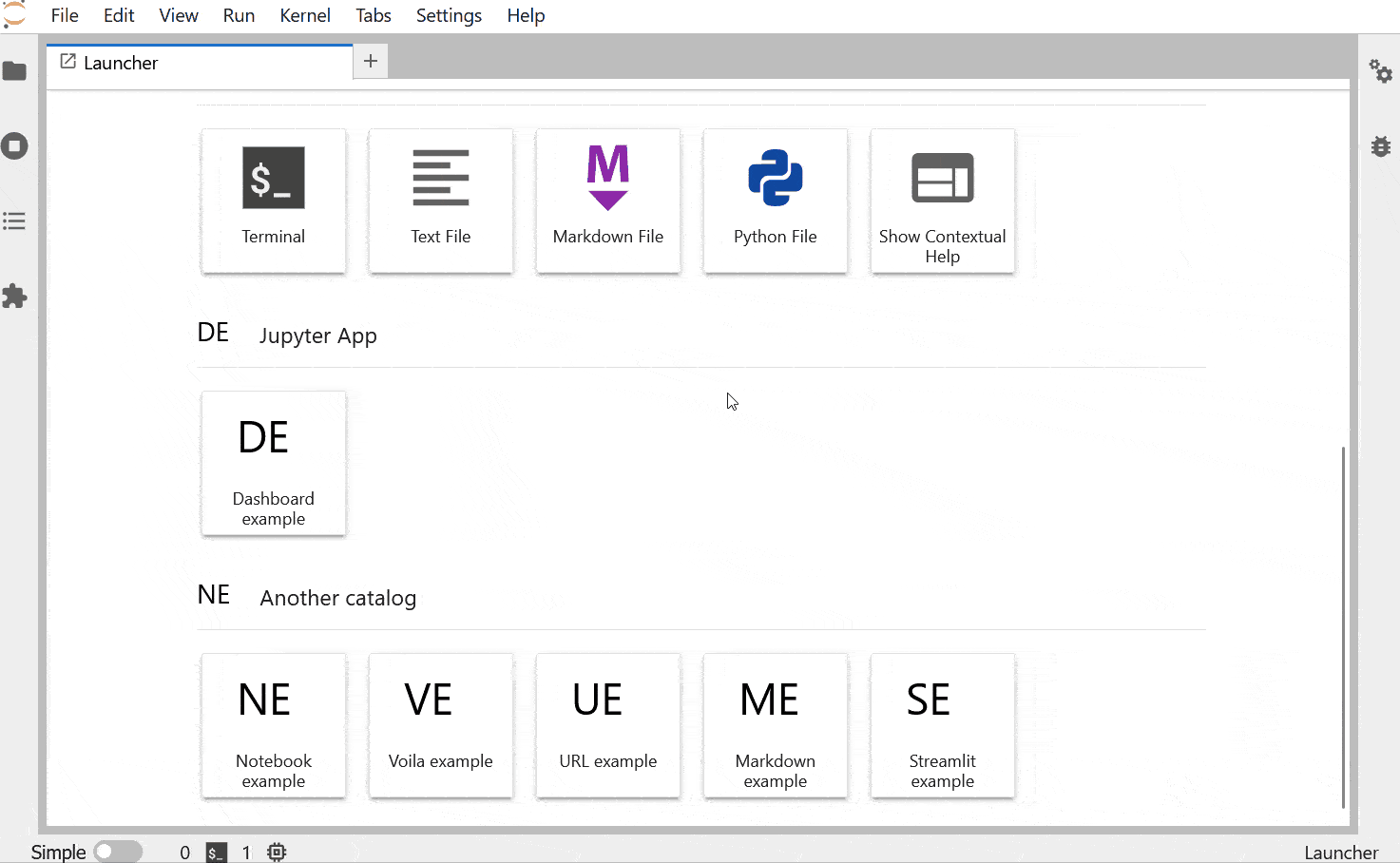
Notebook dashboard demo.#
Note
This dashboard mode does not depend on Voila. It’s a frontend-only approach and is a lightweight solution for dashboarding notebooks.
Users can also open a notebook in this dashboard mode by right clicking on the notebook and select Open With -> Notebook GridStack in the context menu.
Open a notebook with Voila#
This launcher entry also renders the predefined notebook in dashboard mode but unlike notebook-grid, this mode uses Voila and users have access to all configurations of Voila, for example, the template or themes.
- title: Voila example
description: Example of opening a notebook in dashboard mode with Voila
source: ../../samples/sample.ipynb
cwd: ../../samples
type: notebook-voila
args:
theme: dark
template: gridstack
catalog: Another catalog
type=notebook-voilasource: Path to the notebook file. It can be stored anywhere on your system and can be an absolute path or a relative path to the directory of the configuration file.cwd: Unused, Voila will be started in the same directory of the source notebook.args: The arguments list that will be passed to the Voila startup command. For example, in the code block above,--theme=darkand--template=gridstackwill be passed to the Voila command.
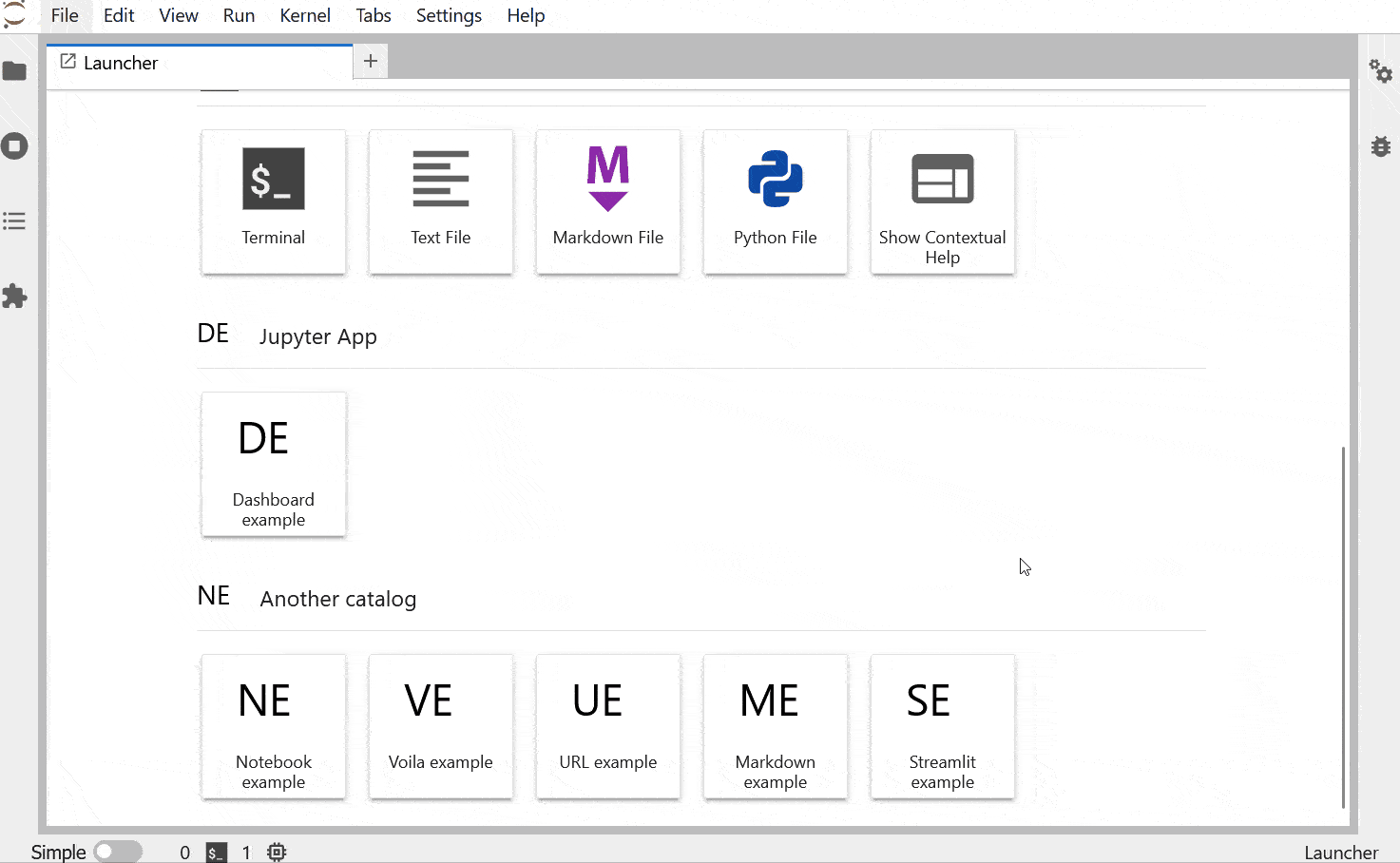
Voila demo.#
Start a local process and open the predefined URL.#
This launcher entry will start a process with predefined commands and open a local URL in a new panel of JupyterLab.
- title: Streamlit example
description: Example of opening a streamlit app
source: http://localhost:$PORT/
cwd: ./
type: local-server
args:
- streamlit
- run
- st_app.py
- --server.headless=true
- --server.port=$PORT
catalog: Another catalog
type=local-serverargs: The command which will be executed inside a sub-process, defined as a list of arguments. For the web server applications that need to define the listening port, users can use the PORT variable.source: The URL which will be opened after executing the command. jupyter_app_launcher will poll for the availability of the URL for 120 seconds. Environment variables inside URL will be substituted with the value of the variable.cwd: Current working directory of the subprocess.
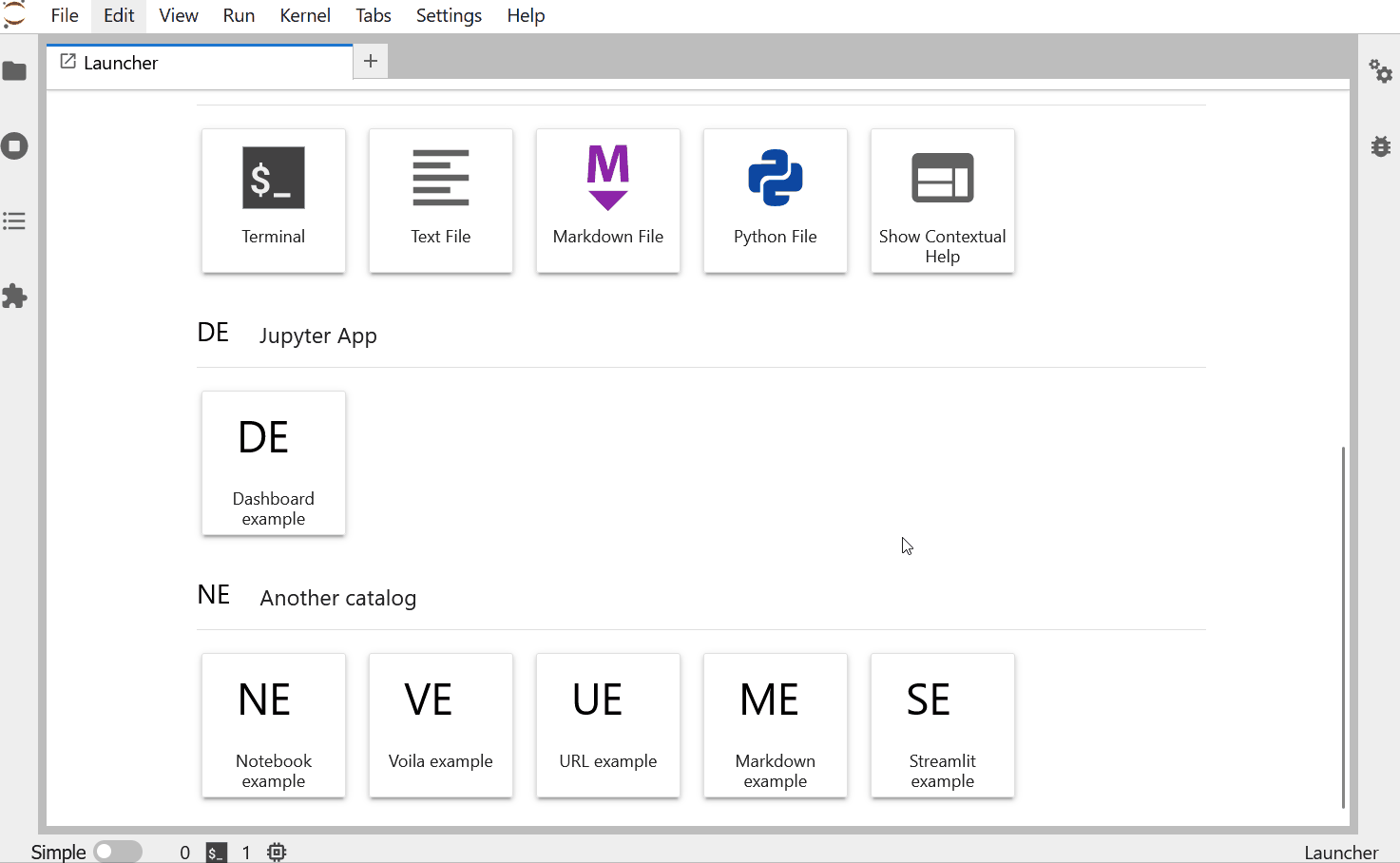
Local server demo.#
Note
jupyter_app_launcher uses the jupyter-server-proxy extension to expose the local URL, so using this entry type behind a reserve proxy server is straightforward.
Open a remote URL.#
This launcher entry will open the predefined URL in a new panel of JupyterLab by using an IFrame element.
- title: URL example
description: Example of opening a URL in a tab
source: https://jupyterlab.readthedocs.io/en/stable/
type: url
catalog: Another catalog
args:
sandbox: [ 'allow-same-origin', 'allow-scripts', 'allow-downloads', 'allow-modals', 'allow-popups']
referrerPolicy: ['no-referrer']
createNewWindow: false
type=urlsource: The URL which will be opened by this entry.args(Optional): The sandbox and referrer policy setting of the IFrame. Alternatively, setcreateNewWindowtotrueto open the URL in a new browser window.cwd: Unused.
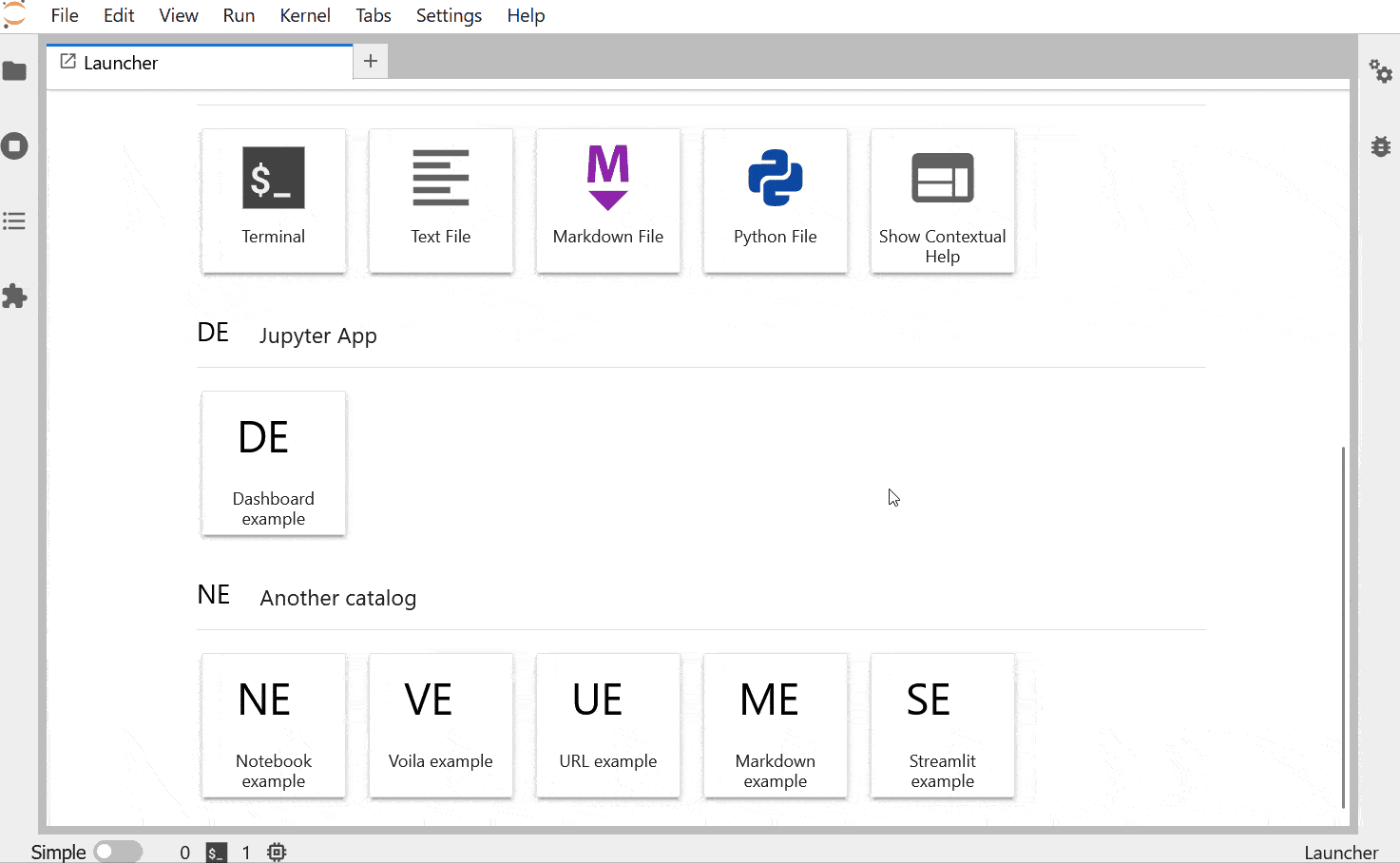
URL demo.#
Run JupyterLab commands.#
This launcher entry will run predefined JupyterLab commands.
- title: Command example 2
description: Example of calling JupyterLab commands
type: jupyterlab-commands
source:
- label: Command 1
id: 'filebrowser:open-path'
args:
path: sample.ipynb
- label: Command 2
id: 'another-jupyterlab-command-id'
args: my-args
catalog: Config 2
type=jupyterlab-commandssource: The list of JupyterLab commands to be called. Each command is defined by 3 property:label: The user-defined label of the command.id: The id of the JupyterLab command.args: The arguments to be passed “as-is” to the command.
args: Unused.cwd: Unused.
The execution of commands will be stopped if a command fails, and the error message will be shown in a dialog.
Running subprocesses manager#
In the case of notebook-voila or local-server launcher entry, jupyter_app_launcher will start the corresponding process in a subprocess. Users can keep track and shut down running subprocesses by using the Launcher Application section in the running panel of JupyterLab

Running subprocess#
Using jupyter_app_launcher with JupyterLite#
jupyter_app_launcher is compatible with JupyterLite, but due to the limit of the lite kernel, the entry types using subprocess do not work in JupyterLite.
The available entry types in JupyterLite are: notebook, notebook-grid, markdown, and url. To use jupyter_app_launcher, users need to add the extension and the configuration file to the deployment.
To add jupyter_app_launcher extension to a JupyterLite website, users can refer to the official documentation here.
To add the configuration to JupyterLite, jupyter_app_launcher provides the command app_launcher to do the process:
jupyter app_launcher build <path-containing-the-YAML-file> <path-to-the -JupyterLite-directory>
The above command will read the config.yaml file in the first path argument and put it in the overrides.json file (the command will create it if needed) of the JupyterLite deployment in the second path argument. Users need to rebuild the deployment to take the changes.
Using jupyter_app_launcher on myBinder#
Users can refer to the example on project repository for deploying jupyter_app_launcher on myBinder.